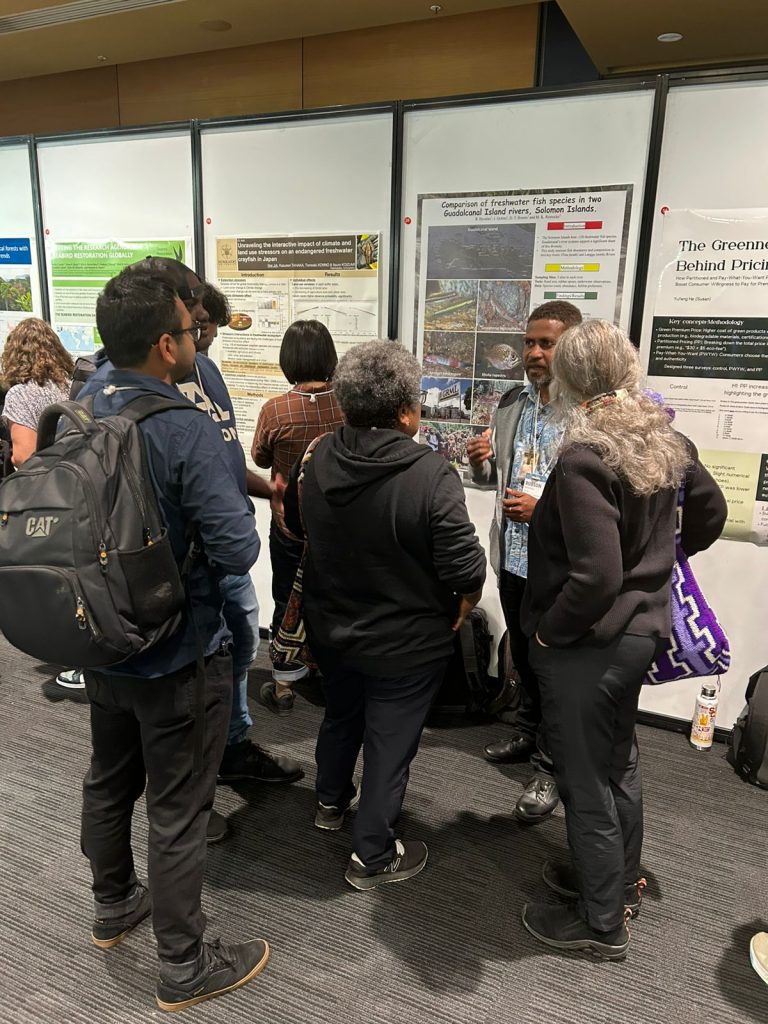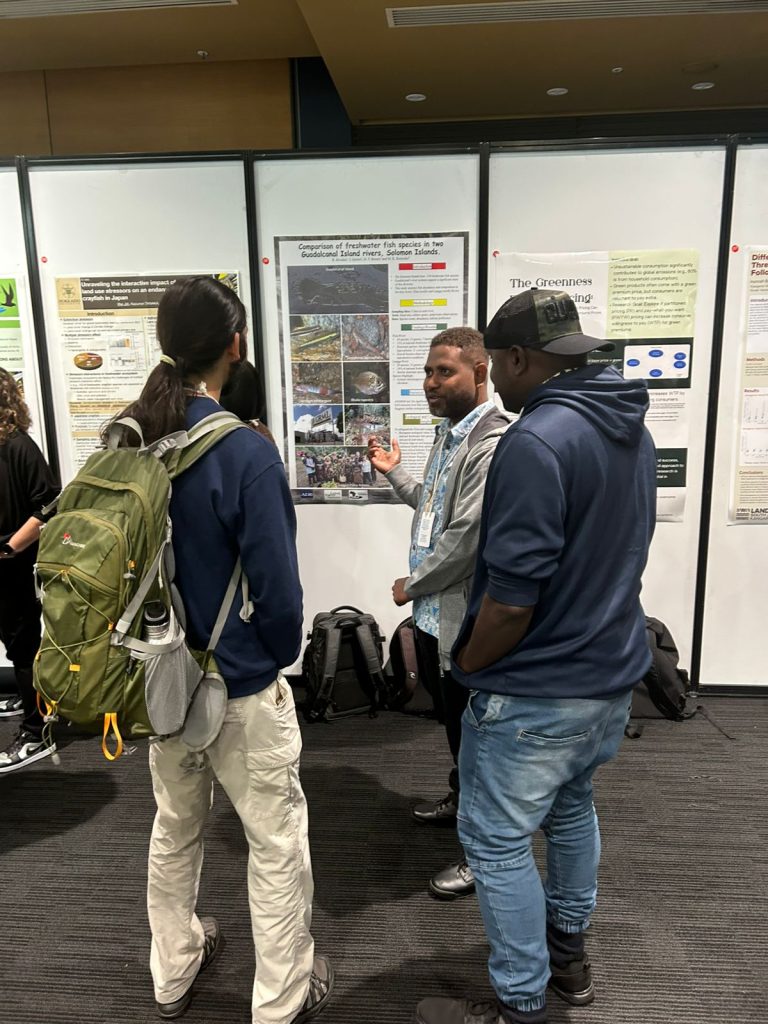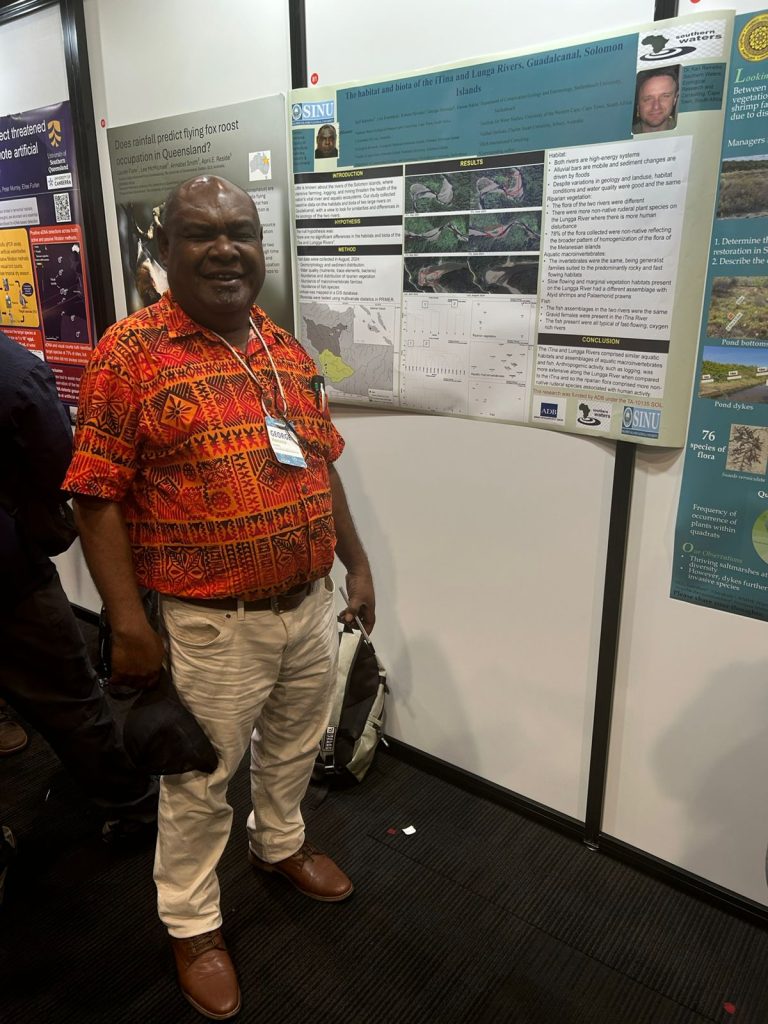Solomon Islands was proudly represented at two prestigious international science events this month.
The events included; the International Congress for Conservation Biology (ICCB) 2025 in Brisbane, Australia and at Taiwan.
At ICCB 2025, the following organizations from Solomon Islands are attending the conference. They are; 1. Baru Conservation Alliance, 2. The Nature Conservancy, 3. Solomon Islands National University and 4. Ecological Solutions Solomon Islands (ESSI).
Three Solomon Islands researchers presented new findings from their collaborative study on the freshwater biodiversity of Guadalcanal Island.
The team’s research focused on two key rivers — the iTina River in the south and the Lungga River in the north.
Mr. Robson Hevalao, an environmental and social safeguard expert working in aquatic ecology, presented a poster titled: “Comparison of Freshwater Fish Species in Two Guadalcanal Island Rivers, Solomon Islands.”

The study used an ecological comparison method called ANOSIM, which revealed no significant difference in fish composition between the two rivers.
This suggests that both rivers, despite being geographically separated, support similar fish communities and ecological conditions — a promising sign that their upper catchments remain relatively healthy and productive.
However, the rivers are facing increasing threats from logging, mining, and land-use changes.

Mr. Isaac Qoloni, an emerging freshwater biologist, co-author of the study, reflected on his participation at ICCB as a “once-in-a-lifetime opportunity” to connect with leading global scientists and learn about the latest in conservation, sustainable development, biodiversity protection, indigenous knowledge, and climate resilience.
Also representing Solomon Islands was Mr. George Horoasia, a lecturer in Environmental Studies at the Solomon Islands National University (SINU), who presented another important study titled: “An Exploration of Catchment Signatures of the Biota of Two Rivers on Guadalcanal, Solomon Islands.”
His research explored whether riparian plants and aquatic macro-invertebrates — insects and organisms living in the water — showed differences between the two rivers.
The findings revealed that riparian plant communities varied significantly due to catchment differences and human activities while aquatic insects were more influenced by local habitat features, such as river rocks and water flow.

Adding to the country’s presence on the international science stage, Mr. David Boseto, a renowned national aquatic ecologist, participated in IPFC12 in Taiwan, where he presented his work on diadromous fish species — fish that migrate between freshwater and the ocean.
He highlighted the importance of understanding fish life cycles, movement patterns, and habitat connectivity, especially in rivers where infrastructure like dams could disrupt natural migration routes.
Mr. Boseto continues to mentor young Solomon Islands researchers and plays a key role in building the country’s capacity in aquatic conservation.
The Solomon Islands delegation acknowledged the support of the iTina communities, whose openness and local knowledge made the research possible.
They also extended thanks to the Solomon Islands Government, and key development partners including the Asian Development Bank (ADB) through the TA-10135 SOL: Capacity Development for Sustainable Rivers Management, Ecological Solution Solomon Islands, Southern Waters, and other national, regional, and international institutions working tirelessly to protect Solomon Islands’ biodiversity and support its people.
The three researchers would also like to acknowledge Dr. Francesco Ricciardi, a Senior Environment Specialist for the Asian Development Bank, who is very instrumental in supporting the three researchers to present at ICCB, 2025.
As the country grapples with the dual pressures of development and environmental change, the researchers emphasized the urgency of protecting our environment, including rivers and streams, which are not only lifelines for local communities but also homes to a rich diversity of species.
Their collective message to the global conservation community was clear: Solomon Islands rivers matter, and by combining science, traditional knowledge, and strong partnerships, their future can be safeguarded for the next generation.
All photos supplied by Dr. Francesco Ricciardi









